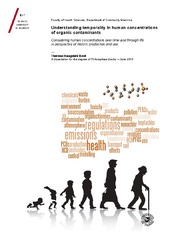Understanding temporality in human concentrations of organic contaminants -Considering human concentrations over time and through life in perspective of historic production and use
Permanent link
https://hdl.handle.net/10037/8257View/
Thesis introduction and appendix (PDF)
Persistent organic pollutants in Norwegian men from 1979 to 2007: Intraindividual changes, age–period–cohort effects, and model predictions. Also available in Environmental Health Perspectives, volume 121, issue 11-12, Nov-Dec 2013 Reproduced with permission from Environmental Health Perspectives (PDF)
Person‐specific predictions of PCBs in Norwegian women: Valuable supplements to measurements for understanding of time‐variant exposures. (Manuscript). Published version, with altered title, available in Environmental Health Perspectives, advance publ. July 2015 Reproduced with permission from Environmental Health Perspectives (PDF)
Date
2014-06-25Type
Doctoral thesisDoktorgradsavhandling
Author
Nøst, Therese HaugdahlAbstract
Modern human lifestyle depends on a great number of synthetic chemicals and many designated as persistent organic pollutants (POPs). There are concerns for harmful health effects of POPs even for the background exposure experienced by the general population and especially for foetuses and children.
The overarching aim of this thesis was to enhance our understanding of how human concentrations of POPs have changed in individuals over time. Five repeated measurements from 54 men in the Tromsø Study, Northern Norway provided longitudinal serum data from 1979 to 2007 for polychlorinated biphenyls (PCBs), organochlorine pesticides and per- and polyfluoroalkyl substances (PFASs). Concentrations of most PCBs and pesticides decreased from 1979 or 1986 and likely reflect the decreasing concentrations in the environment during the same period. Concentrations increased for some PFASs from 1979 until 2001 when major productions were phased out and decreased to 2007. For other PFASs, concentrations increased during the entire study period. Many of the compounds measured were banned before or during the study period and the time trends of POP concentrations display a strong link to production and use of these compounds. These time trends clearly show that initiatives to stop production and use of POPs have led to decreasing concentrations of the same POPs in humans.
Measured concentrations of PCBs were compared with concentrations predicted by emission-based mechanistic exposure modelling. The model simulations for PCB concentrations demonstrated reliable performance to reproduce median measured concentrations of PCBs in the Northern Norwegian men. Person-specific predictions were obtained for pregnant and postmenopausal women and they were in agreement with measurements. Predicted concentrations from birth until blood sampling for the study subjects demonstrated large differences between individuals in peak concentrations and temporal changes. Also, these results demonstrate the potential of mechanistic models as useful tools in human biomonitoring and effect studies.
Description
Paper II of this thesis is not available in Munin.
Repeated measurements of per‐ and polyfluoroalkyl substances (PFASs) from 1979 to 2007 in males from Northern Norway: Assessing time trends, compound correlations and relations to age/birth cohort. Nøst, TH, Vestergren, R, Berg, V, Nieboer, E, Odland, JØ, Sandanger, TM.
Available in Environment International, 2014, vol. 67
Repeated measurements of per‐ and polyfluoroalkyl substances (PFASs) from 1979 to 2007 in males from Northern Norway: Assessing time trends, compound correlations and relations to age/birth cohort. Nøst, TH, Vestergren, R, Berg, V, Nieboer, E, Odland, JØ, Sandanger, TM.
Available in Environment International, 2014, vol. 67
Publisher
UiT The Arctic University of NorwayUiT Norges arktiske universitet
Series
ISM skriftserie; 151Metadata
Show full item recordCollections
- Doktorgradsavhandlinger (Helsefak) [770]
- ISM skriftserie [161]
Copyright 2014 The Author(s)
The following license file are associated with this item:


 English
English norsk
norsk
